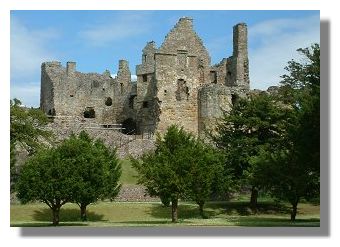Dirleton's Gardens
 Many of Scotland's castles impress because of their gloomy grandeur and violent history. Dirleton (pronounced as if the 'e' was not there) had its moments of turbulence too, but the well manicured gardens (one of which was laid out in the 16th century, another laid out to a plan made in 1865) and a bowling green which nestle beside the castle give it a different air.
Many of Scotland's castles impress because of their gloomy grandeur and violent history. Dirleton (pronounced as if the 'e' was not there) had its moments of turbulence too, but the well manicured gardens (one of which was laid out in the 16th century, another laid out to a plan made in 1865) and a bowling green which nestle beside the castle give it a different air.
Visitors enter the grounds of the castle via the garden which was laid out in its present form in the late 1920s in the "Arts and Crafts" style. The herbaceous border runs continuously round the garden (with only a very small break to allow visitors to pass through without having to retrace their steps or walk across the planted area). In these days of "biggest and best" the Guinness Book of Records says that Dirleton has the "longest continuous hebaceous border in the world".
Early History of the Castle

The Dirleton estate was acquired by the de Vaux family, from Rouen in Normandy, in the reign of King Malcolm IV (1153-1165).
The Scottish de Vaux family gifted land to the church, including that of Dryburgh Abbey in the Scottish Borders around 1220. Later in the 13th century, John de Vaux became steward to Alexander II's young Queen, Marie de Coucy. It was round about this time that the present castle was first built.
Dirleton Castle became one of the grandest castles of its day, both in terms of its defensive capabilities and in its impressive grandeur. It was strong enough to resist an English siege in 1298 - although the castle was eventually taken when food ran out. However, in 1314 Robert the Bruce was determined to ensure that the invading English army could not use it as a base again and ordered its destruction after it had been retaken during the Wars of Independence.
Despite this (and later damage), a large amount of the original de Vaux castle has survived, making it one of the most complete 13th century castles in Scotland.
Plots Against the Monarch
The last de Vaux lord died without a male heir and the castle and its barony passed to the Halyburton family who rebuilt the castle, adding a great hall. The Halyburtons remained at Dirleton for 200 years, during which time the barony became a lordship.
 In 1505, the last Lord Halyburton died and the castle became part of the estates of the Ruthven family through marriage. The 3rd Lord Ruthven was a staunch Protestant and was one of the main culprits in the murder of one of Mary Queen of Scots' favourites, David Riccio in 1566.
In 1505, the last Lord Halyburton died and the castle became part of the estates of the Ruthven family through marriage. The 3rd Lord Ruthven was a staunch Protestant and was one of the main culprits in the murder of one of Mary Queen of Scots' favourites, David Riccio in 1566.
In 1582 the newly created Earl of Gowrie was involved in a plot - The Ruthven Raid - to capture King James VI and hold him in the Earl's house in Perth. Although he was pardoned for this, he eventually overstepped the mark in a plot to seize Stirling castle in 1585 and was beheaded. But the 3rd Earl Gowrie became identified with another plot against the king in 1600 - the so-called "Gowrie Conspiracy".
Despite these tempestuous times, the Ruthvens found time to create a formal garden, known as a "pleasance" possibly with a knot garden. The yew trees surrounding the present bowling green are the descendants of a yew hedge which surrounded it. The dovecot which has survived intact was also built towards the end of the 16th century.

Following the forfeiture of Dirleton Castle as a result of the various plots, King James VI gave the castle to Sir Thomas Erskine - perhaps as a reward for being responsible for killing Alexander Ruthven! However, it was sold in 1625 to Sir James Douglas.
In November 1650 Oliver Cromwell sent 1,600 men to capture the castle because it was being used by Royalist "moss-troopers" to attack his supply lines. The force, commanded by General Monk, had guns which proved to be no match for the castle's defences and demolished the inner gate and drawbridge. After being used for a time as a field hospital during the remaining conflicts of the Civil War, the damaged castle was left to decay.
The esatate was bought in 1663 by a Berwickshire family, the Nisbets but they built a new mansion nearby at Archerfield. The gardens and orchard were maintained, however, and the knot garden was turned into a bowling green for the villagers.
How to Find Dirleton
Dirleton is within easy reach of Edinburgh, being only 20 miles east of the capital. Take the main A1 road east and then fork left along the A198 coastal road via Musselburgh, Prestonpans and the golf courses of Luffness and Gullane to Dirleton. The castle is now administered by Historic Scotland and is open Monday to Saturday from 9.30am to 6.30pm during April to September (2pm-6.30pm on Sunday). During October to March there are restricted opening hours.
For a detailed location map, see this StreetMap UK map of the area. (Note that you can access a larger scale map of the area via that Web page).



